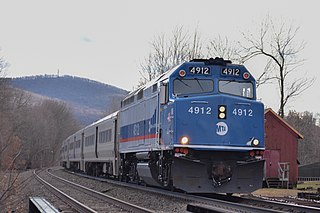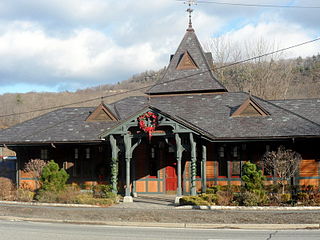
The Main Line is a commuter rail line owned and operated by New Jersey Transit running from Suffern, New York to Hoboken, New Jersey, in the United States. It runs daily commuter service and was once the north–south main line of the Erie Railroad. It is colored yellow on NJ Transit system maps, and its symbol is a water wheel.

NJ Transit Rail Operations is the rail division of NJ Transit. It operates commuter rail service in New Jersey, with most service centered on transportation to and from New York City, Hoboken, and Newark. NJ Transit also operates rail service in Orange and Rockland counties in New York under contract to Metro-North Railroad. The commuter rail lines saw 57,179,000 riders in 2023, making it the third-busiest commuter railroad in North America and the longest commuter rail system in North America by route length.

The Port Jervis Line is a predominantly single-track commuter rail line running between Suffern and Port Jervis, in the U.S. state of New York. At Suffern, the line continues south into New Jersey on NJ Transit's Main Line. The line is operated by NJ Transit Rail Operations under a contract with Metro-North Railroad (MNRR).

New York State Route 211 (NY 211) is a state highway located entirely within Orange County, New York, in the United States. The western terminus is at the intersection with US 209 located in Cuddebackville, and the eastern terminus is located at Montgomery at NY 17K, where it becomes the main thoroughfare.

Pavonia Terminal was the Erie Railroad terminal on the Hudson River located in the Harsimus section of Jersey City, New Jersey. The station opened in 1861 and closed in 1958 when the Erie Railroad moved its passenger services to nearby Hoboken Terminal. The New York, Susquehanna and Western Railway also ran commuter trains from the terminal and various street cars, ferries and the underground Hudson and Manhattan Railroad serviced the station. The station was abandoned in 1958 and demolished in 1961. The site was eventually redeveloped into the Newport district in the late 20th century.

Salisbury Mills–Cornwall station is a commuter rail stop owned by Metro-North Railroad serving trains on the Port Jervis Line, located in the Beaver Dam Lake section of the town of Cornwall, New York. The station is located at the northern end of the Moodna Viaduct, accessible from NY 94.

Suffern station is a railroad station in the village of Suffern. The station, located on Ramapo Avenue in Suffern, services trains of New Jersey Transit's Main Line and Metro-North Railroad's Port Jervis Line. Suffern station serves as the terminal for Main Line trains, as trains continue north into Hillburn Yard. The next Main Line station, located in New Jersey, is Mahwah. The next Port Jervis Line station to the north is Sloatsburg. The station consists of two low-level side platforms for trains in both directions, neither of which are handicap accessible for the Americans with Disabilities Act of 1990.

Campbell Hall station is a commuter rail stop owned by Metro-North Railroad serving trains on the Port Jervis Line, located just south of the hamlet of Campbell Hall, New York in the town of Hamptonburgh. The station is located at the end of Watkins Road, off Egbertson Road. The station contains decorative lights, a long platform roof and an elevated mini-high platform at the east end of the station for access by riders in wheelchairs. Parking is on a permit/meter system.

Middletown–Town of Wallkill station, often just referred to as the Middletown station, is a commuter rail stop owned by Metro-North Railroad serving trains on the Port Jervis Line in the town of Wallkill, New York. The station is located in the latter municipality along the former Erie Railroad Graham Line.

Harriman station is a commuter rail stop owned by Metro-North Railroad serving trains on the Port Jervis Line, serving the village of Harriman, New York, the town and village of Monroe, and the town of Woodbury in Orange County, New York. Before its use as a station, the area was better known as "Newburgh Junction" and was where the Erie Railroad's mainline separated from the Newburgh Shortcut. This junction was controlled by "NJ" interlocking tower and, while the mainline has been abandoned since 1983, the wye remains intact.

Tuxedo station is a commuter rail stop owned by Metro-North Railroad serving trains on the Port Jervis Line, located in the town of Tuxedo, New York, with commuter rail to Hoboken and its connections to New York City.

Sloatsburg station is a commuter rail stop owned by Metro-North Railroad serving trains on the Port Jervis Line, located in the village of Sloatsburg, New York at the intersection of Municipal Plaza and Mills Street.

Port Jervis station is a commuter rail stop owned by Metro-North Railroad serving trains on the Port Jervis Line, located in Port Jervis, New York. It is the western terminus of the Port Jervis Line.

The Port Jervis station is a disused train station at the corner of Jersey Avenue and Fowler Street in Port Jervis, New York. It was built in 1892 as a passenger station for the Erie Railroad by Grattan & Jennings in the Queen Anne style. For years it was the busiest passenger station on the railroad's Delaware Branch because Port Jervis is along the Delaware River near the tripoint of New York, New Jersey, and Pennsylvania. The long-distance passenger trains Erie Limited and the Lake Cities between Chicago and Hoboken served this station.

The Otisville Tunnel is the longest tunnel on New York's Metro-North commuter railroad, at 5,314 feet (1,620 m) in length. Although the track curves at the western opening, underground the tunnel is a straight line, allowing the observer to see all the way through.

The Orange Heritage Trailway is a 19.5-mile (31.4 km) rail trail in Orange County, New York, that runs along the roadbed of the Erie Railroad's Main Line from Monroe, NY to nearby Middletown.

Harriman Station, formerly known as Turner Station until 1910, was the first station on the Erie Railroad Main Line west of Newburgh Junction in Harriman, New York. Built adjacent to Grove Street in Harriman, one of the earlier structures built here in 1838 was a three-story hotel-train station combination. This station caught fire in 1873 and was replaced by a one-story wooden structure. That structure remained in use for decades before it began decaying and was replaced in 1911 with a new station on land donated by the widow of Edward Henry Harriman. A new one-story structure was built on the land. The station was maintained as a one-story depot with an adjacent monument dedicated to the work of Charles Minot. Minot was a director of the Erie Railroad who, in 1851, while his train was stopped at Turner, made the first railroad call by telegraph.

The Graham Line is the portion of the former Erie Railroad in New York State from Highland Mills to Guymard, constructed from 1906 to 1909 as a high-speed freight line. The Graham Line bypasses the original Erie Main Line through Monroe, Chester, Goshen and Middletown. Grade on the Graham Line was not to exceed 0.2% eastward or 0.6% westward, while the original Main Line built in the 1840s had grades up to 1.25%. There were three places where freight trains needed a helper on the old line and none on the new, but just west of the cutoff the grade up from Port Jervis to Guymard could not be improved, and remained unchanged as the only place in the area needing a helper. The sharpest curve on the old line was 7 degrees and on the new was 1 deg 30 min. The Graham Line has no grade crossings: a rarity on the Erie. The downside of the improved grade and curvature is that the Graham Line is seven miles longer than the original mainline. Maintaining the desired grade required two notable engineering features: the Moodna Viaduct and the Otisville Tunnel.

Middletown was the main station along the Erie Railroad mainline in the city of Middletown, New York. Located on Depot Street, the station was first opened in 1843 with the construction of the New York, Lake Erie and Western Railroad, which had originally terminated at Goshen. The station was located along the New York Division, which stretched from Pavonia Terminal in Jersey City, New Jersey, to the Sparrowbush station just north of Port Jervis.
The Erie Railroad Newburgh Branch is a mostly abandoned branch line that travels across the center of Orange County, New York. It survives as the CSX Vails Gate Spur between Newburgh and Vails Gate, but is abandoned between Vails Gate and the end of the line in Greycourt. When it opened in 1850, it was Newburgh's first railroad and remained the only line serving the city for over three decades until the first train operated from Newburgh along the West Shore Railroad in 1883.




















